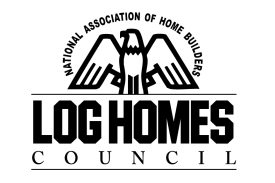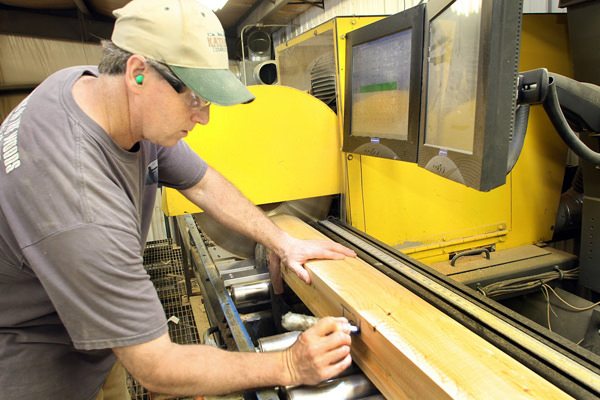In the late 1970s, the Log Homes Council (LHC) was formed to provide some measure of self-regulation and monitoring to an industry that had few guidelines. One of the priorities identified at the initial stages of the organization was the implementation of a log grading program for all Log Homes Council members.
Today, all members must implement log grading based on a specific set of LHC approved guidelines. These guidelines  were developed based on ASTM Standard D3957 to provide a parallel to grading of other lumber products used in traditional building, as well as to assist local building inspectors understand the differences inherent in log versus traditional construction. Edwin Burke, Ph.D., who is a professor at the University of Montana and accredited by the International Accreditation Service, administers the grading program.
were developed based on ASTM Standard D3957 to provide a parallel to grading of other lumber products used in traditional building, as well as to assist local building inspectors understand the differences inherent in log versus traditional construction. Edwin Burke, Ph.D., who is a professor at the University of Montana and accredited by the International Accreditation Service, administers the grading program.
We spoke to Mac Garcia, of Expedition Log Homes in Wisconsin, who currently is Chairman of the Log Homes Council’s Grading Committee. Garcia is certified as a log grading inspector. As such he has taken and passed a two-day inspection course affiliated with the Log Home Council’s guidelines.
Each Log Home Council member company is required to have a certified log grader on staff. Many companies also provide training for their employees so that they too may understand the grading process and assist in grading. The certified log grading inspector in each company is the individual who is responsible for the final grade inspection report for each log home that is shipped.
In addition to the certification program, the LHC member company is also subject to unannounced inspections by a third party Quality Supervisory Agency selected by the LHC for a certain region.
As part of the LHC membership requirements each log home company must provide details on their manufacturing process, engineering specifications and other information to assure the LHC that they are in compliance with the program. Each log is marked with the company’s grade inspection mark and a written Certificate Of Inspection is also included with plans and the shipping list when a log home is shipped.
What is involved in grading a log?
Any log that is considered to be a structural, or load bearing component in a log home must be graded. According to Garcia, new, improved building codes and enforcement are moving more companies toward grading programs, as the local code inspectors require more structural documentation.
Grading programs are a visual examination of the log after it has been machined. The grading helps to determine the amount of load and stress a log can tolerate. The certified log grader looks for a number of visual clues on the log, but the primary features he looks for are knots and the slope of the grain.
One important note: the grading of a log provides no information about the moisture content of the log. That is included in a separate “kiln dried” certificate that ensures that the log has been cured to the acceptable moisture level for shipping. Katahdin’s moisture level is between 12-14% at the time of shipment.
Knot inspections
According to Garcia, there are 32 different types of knots. Some knots are acceptable, but others will disqualify a log from use in structural application. These lower grade logs will instead be utilized in tongue and groove paneling, trim, or facings. Larger knots are not allowed, and the effect on the log’s grade is based on the relationship between the diameter of the log and the knot’s size. For a 10-inch diameter round truss or purlin log, the maximum size knot allowed in the #1 grade would be 1-3/4 inches. For a wall grade log that has an inscribed rectangle of 7 inches square, the allowable knot size must be less than 4.25 inches. Each grader, as part of the certification training, learns the size, distribution and number of knots that would delineate a log from a grade 1 to 2 or lower.
 Slope of Grain
Slope of Grain
Each log is also inspected for the slope of grain. This is measured by drawing a line down the center of a log face and measuring the angle from parallel that the grain has along that line. The less deviation from the straight centerline, the stronger the log is. For grading purposes, a total deviation of 1 inch for every 14 inches of length is the maximum slope allowed for a grade 1 log. A grade 2 log might have a grain slope of 1 inch per 10 inches, a much steeper variation.
At Katahdin, the Certified Log Inspectors are Wendell Hersey and Bruce Hall. Hersey also operates the computerized house manufacturing line at the Oakfield mill and Hall operates the purlin line. The wall logs are given a preliminary grade as they pass through the planer before reaching the house line. Then as each log passes through the line, Hersey inspects it for any defects that would reject it for structural use. The planed logs travel through the house line where they are bar-coded, stamped with a grade number, and cut and drilled to the design specifications. A similar process is followed for the purlin logs.
The Log Homes Council’s Log Grading Program is an essential part of ensuring that our industry has consistent quality. As a member, we encourage our customers to ascertain whether the log home companies they are considering are also members of the Log Homes Council.
